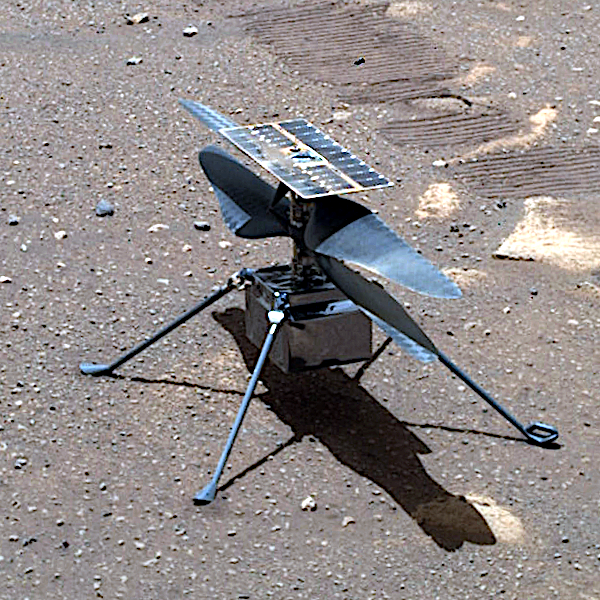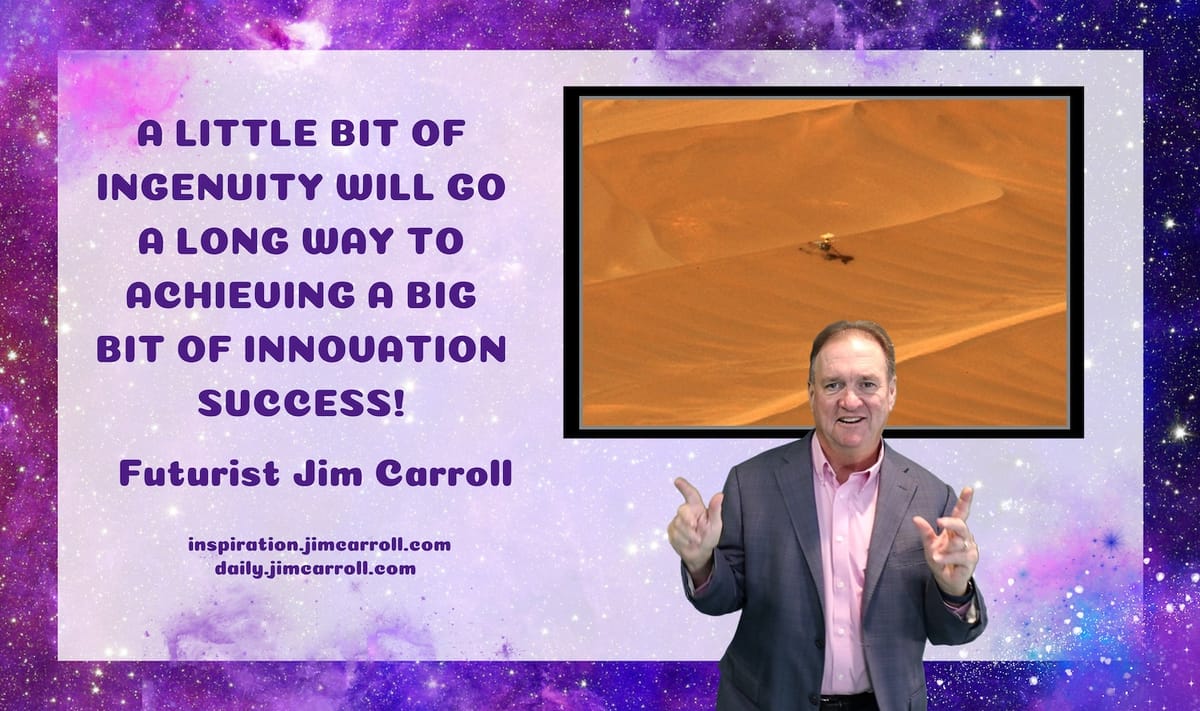"A little bit of ingenuity will go a long way to achieving a big bit of innovation success!" - Futurist Jim Carroll
Any innovation story would not be complete without a little bit of Ingenuity.
The NASA Mars drone, Ingenuity, that is. It's the little spacecraft that could!
NASA ’s history-making Ingenuity Mars Helicopter has ended its mission at the Red Planet after surpassing expectations and making dozens more flights than planned. While the helicopter remains upright and in communication with ground controllers, imagery of its Jan. 18 flight sent to Earth this week indicates one or more of its rotor blades sustained damage during landing, and it is no longer capable of flight.
Originally designed as a technology demonstration to perform up to five experimental test flights over 30 days, the first aircraft on another world operated from the Martian surface for almost three years, performed 72 flights, and flew more than 14 times farther than planned while logging more than two hours of total flight time.
“The historic journey of Ingenuity, the first aircraft on another planet, has come to end,” said NASA Administrator Bill Nelson.
“That remarkable helicopter flew higher and farther than we ever imagined and helped NASA do what we do best – make the impossible, possible. Through missions like Ingenuity, NASA is paving the way for future flight in our solar system and smarter, safer human exploration to Mars and beyond.”
NASA’s Ingenuity Helicopter Mission Ends
29 January 2024m Space & Defence'
The picture in today's quote is Ingenuity's final resting place after its flight; it was discovered after some searching of the Martian Dunes by its parent Perseverance. It brings to an end not only a remarkable mission in space but a wonderful story of new forms of innovative thinking at NASA with many innovation leadership lessons to be learned.

What are those lessons?
First and foremost, innovate on the fly! Most NASA missions are highly complex, tightly scripted affairs using NASA-built technologies - every step is determined in advance, carefully rehearsed, and never deviated from. That's a necessity in the dangerous moments of launch and the harsh environment of space. And yet Ingenuity allowed a team at NASA to step outside this normal way of doing things in several ways, particularly from a collaboration, design, development, and innovation methodology perspective. The entire mission unfolded in a way that was unscripted, unplanned, and wildly successful.
Second, abandon the typical way of doing things and explore new concepts. The project itself used several 'off-the-shelf' parts, unheard of in most spacecraft designs - NASA designs mostly every single part that goes into space. Case in point - when I spoke and got a tour of NASA's Goddard Space Center, I witnessed a typical NASA facility that undertook a very complex, time-consuming, and expensive facility that designed every component of every craft. At one point, my son and I got to visit what the NASA team called 'The Shake and Bake Building,' where every piece of spacecraft was subjected to the rigors of launch and space flight - including a sound room with subwoofers that were at least a hundred feet high. That's used to subject each tiny new spacecraft component to the sound it will encounter at launch. (They told us if they put us inside, closed the door, and turned up the volume, we would probably die, such is the loudness of the room!)
This was not the case with all the competitors of Ingenuity - notably, it featured several 'off-the-shelf' components:
- a Qualcomm Snapdragon 801 processor: This is the main engine of the helicopter, originally used in smartphones such as the Samsung Galaxy S5, Sony Xperia Z3, and LG G3.
- a 0.5-megapixel down-facing navigation camera from Omnivision: it's a lower resolution camera used for navigation purposes.
- a 13-megapixel front camera built by Sony: a higher resolution camera to capture detailed images of the Martian terrain from high above.
The key lesson? Through the mission, NASA learned that utilizing off-the-shelf components could be highly effective for future missions, realizing that commercially available technology could work in a complex mission and might provide a better solution. The Qualcomm flight platform provided a powerful processor that was 100 times as powerful as the one on the Perseverance rover, enabling the helicopter to process a significant amount of data and handle autonomous flight operations pretty effectively! What did NASA learn through this new approach? That integrating commercial technology was entirely feasible - and is indicative of a new willingness to design missions and spacecraft in new and different ways.
Third, the organization also learned about the power of forming 'fast teams,' a topic I often discuss at my events. The original plan was that little Ingenuity might perhaps make one flight - if it succeeded at all. (It ended up making 72!). Once the core Ingenuity mission team realized that it was becoming the 'little space drone that could,' they pulled in a vast number of cross-disciplinary team members, including experts in materials, thermal engineering, aerodynamics, power systems, and structural analysis. They all worked together to scope out and design flight missions that went FAR BEYOND the original mission specifications - in effect, NASA learned how to build an ad-hoc team on the fly that could and would pursue innovative and radical ideas to pursue ideas that were never part of the original mission intent.
This parallels what organizations must do in our volatile world of today - you've got to take on projects that you are not yet aware of, with a team not yet assembled, pursuing projects not yet defined, for goals not yet clear, with skill sets that you don't yet know of. Does that sound familiar?
There were many other ideas that the NASA team pursued that were never part of the original mission, including
- iterative design on the fly (designing new missions based on real-world data from Mars, which differed from simulations on Earth), thus learning how to innovate in new and different ways;
- innovation with autonomous technology: Ingenuity's ability to autonomously select landing sites and navigate Mars' terrain demonstrated the potential for future missions to incorporate more autonomous features, reducing the need for direct human intervention and allowing exploration of areas inaccessible to rovers. This has HUGE implications going forward in terms of overall mission mindset.
- pushing original mission boundaries: Ingenuity's mission pushed the limits of what was considered possible for flight on Mars, both in terms of speed and altitude. The willingness of the team to test the boundaries of the helicopter's capabilities broke a long-standing NASA practice that every step in every mission must fit within a previously defined set of goals and standards, a significant cultural change that will have long-lasting implications.
In summary, NASA's experiences with the Ingenuity mission and other collaborative efforts have reinforced the importance of interdisciplinary teamwork, adaptability, autonomous technology, rigorous risk management, pushing technological limits, effective remote collaboration, private sector partnerships, and innovative problem-solving methodologies. That's a lot of lessons learned.
And it goes to prove that a little bit of Ingenuity can go a long way towards achieving a big bit of innovative thinking!
A long-time space nerd, Futurist Jim Carroll has spoken at two major events at NASA on the topic of the 'future of space,' leadership, collaboration, and creative thinking. These events remain among the highlights of his long speaking career.

